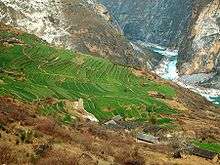Tiger Leaping Gorge
Tiger Leaping Gorge (Chinese: 虎跳峡; pinyin: Hǔ tiào xiá) is a scenic canyon on the Jinsha River, a primary tributary of the upper Yangtze River. It is located 60 kilometres (37 mi) north of Lijiang City, Yunnan in southwestern China. It is part of the Three Parallel Rivers of Yunnan Protected Areas World Heritage Site.
| Tiger Leaping Gorge | |||||||||||||||||||||
|---|---|---|---|---|---|---|---|---|---|---|---|---|---|---|---|---|---|---|---|---|---|
.svg.png) "Tiger Leaping Gorge" in Simplified (top) and Traditional (bottom) Chinese characters | |||||||||||||||||||||
| Simplified Chinese | 虎跳峡 | ||||||||||||||||||||
| Traditional Chinese | 虎跳峽 | ||||||||||||||||||||
| |||||||||||||||||||||


Legend says the name comes from a hunted tiger escaping by jumping across the river at the narrowest point (still 25 metres (82 ft) wide), using the rock in the middle.[1][2]
At a maximum depth of approximately 3,790 meters (12,434 feet) from river to mountain peak, Tiger Leaping Gorge is one of the deepest and most spectacular river canyons in the world.[3] The inhabitants of the gorge are primarily the indigenous Naxi people, who live in a handful of small hamlets. Their primary subsistence comes from grain production and hikers.
Geography
Around 15 kilometres (9.3 mi) in length, the gorge is located where the river passes between the 5,596 metres (18,360 ft) Jade Dragon Snow Mountain and the 5,396 metres (17,703 ft) Haba Snow Mountain in a series of rapids under steep 2,000 metres (6,600 ft) cliffs.
Administratively, the river in this area forms the border between Yulong Naxi Autonomous County of Lijiang City (right bank) and Shangri-La County of Diqing Tibetan Autonomous Prefecture (left bank).
The gorge is not considered navigable. In the early 1980s, four rafters attempted to go down the gorge and were never seen again. In 1986, the first known successful attempt to sail through the gorge was made by the first expedition to float down the entire length of the Yangtze, starting at the river's high source at the Gelandandong glacier lake.[4]
The area was officially opened to foreign tourists in 1993,[5] but had attracted adventurous backpackers already in the 1980s. Officials plan to improve the existing trails and roads, bringing tour buses and more development. These plans arouse highly varied reactions among the local population, from strong opposition to strong support.[5]
Natural crystals are mined from areas in and surrounding the Tiger Leaping Gorge.
Climate
| Climate data for Tiger Leaping Gorge | |||||||||||||
|---|---|---|---|---|---|---|---|---|---|---|---|---|---|
| Month | Jan | Feb | Mar | Apr | May | Jun | Jul | Aug | Sep | Oct | Nov | Dec | Year |
| Average high °C (°F) | 16.2 (61.2) |
17.4 (63.3) |
20.6 (69.1) |
23.3 (73.9) |
26.1 (79.0) |
26.2 (79.2) |
26.2 (79.2) |
26.0 (78.8) |
24.8 (76.6) |
22.6 (72.7) |
19.6 (67.3) |
16.8 (62.2) |
22.1 (71.9) |
| Daily mean °C (°F) | 9.2 (48.6) |
10.9 (51.6) |
13.8 (56.8) |
16.9 (62.4) |
20.0 (68.0) |
21.4 (70.5) |
21.8 (71.2) |
21.4 (70.5) |
20.2 (68.4) |
17.1 (62.8) |
13.0 (55.4) |
9.9 (49.8) |
16.3 (61.3) |
| Average low °C (°F) | 2.2 (36.0) |
4.4 (39.9) |
7.1 (44.8) |
10.5 (50.9) |
14.0 (57.2) |
16.7 (62.1) |
17.5 (63.5) |
16.8 (62.2) |
15.6 (60.1) |
11.7 (53.1) |
6.4 (43.5) |
3.0 (37.4) |
10.5 (50.9) |
| Average precipitation mm (inches) | 8 (0.3) |
22 (0.9) |
39 (1.5) |
48 (1.9) |
68 (2.7) |
175 (6.9) |
201 (7.9) |
175 (6.9) |
133 (5.2) |
83 (3.3) |
18 (0.7) |
8 (0.3) |
978 (38.5) |
| Source: Climate-Data.org | |||||||||||||
Tiger Leaping Gorge weather is generally mild, with abundant rainfall and plenty of sunshine. It has an average annual temperature between 13°C (55 F) and 20°C (68 F), without too much change from spring to winter. In summer, the temperature just falls between 10 - 26°C (50 - 79 F) low because of the continuous rain. Coming to winter, the high mountains block the cold air from northern China, so it is still as warm as spring for most of the days.
Spring:
March and April are best months to hike in Tiger Leaping Gorge for comfortable weather with temperatures up to 20°C. Take a light jacket. May is even more warmer than April and there are more blooming flora.
Summer:
It's the rainy season of Tiger Leaping Gorge from June to September. The heavy rain may result in the gorge being closed on certain days.
Autumn:
The scenery from mid-autumn to November is also excellent. Usually dry and sunny, bring a long-sleeve, light sweater and a coat.
Winter:
A good time to hike the gorge for the sunny weather, dry and clear. It's cold at night and chilly at morning.
Best time to visit
Tiger Leaping Gorge hike can be undertaken at any time around the year as it enjoys a mild climate even in winter (5-15 degrees Celsius), but the temperature difference of a day is great. Most of the days are sunny and dry; however, it rains a lot during the rainy season from July to September and there is some risk that paths could be blocked due to landslides. Check the Tiger Leaping Gorge Weather Forecast before you visit.
Roads and trails
Hiking the length of the gorge is possible. The hiking path ("the high road") is well-maintained and marked, although sometimes narrow, and at times impassable due to heavy rains, and is used by the Naxi as part of everyday life. This trail is longer than the lower road, approximately 22 kilometres (14 mi), but is more varied. It features a variety of micro-ecosystems, waterfalls, and a fair number of guesthouses for trekkers. These guesthouses are not well heated, which combined with the unpredictable nature of high mountain weather makes this trek unadvisable during the rainy season.
The lower road, stretching about 195 km (121 mi) from Qiaotou through the Gorge, is a stretch of pavement (until recently a simple mule track) crossed by several waterfalls, and frequently beset by rockslides. Some portions of the road have been known to disappear into the river below. The road follows the Yangtze, so there are more views of the river, and a stronger sense of being in a gorge than on the upper trail. Where the high road descends to meet the lower road, one can climb down to the river near the Tiger Leaping Stone, the point at which the tiger is said to have leaped.[6] In July 2010, the Chinese government closed the gorge to visitors because a new lower road was being built. Consequently, there were no government officials to charge the 50 yuan fee to enter the trail. Locals requested a 10 yuan fee to enter the trail. Many trekkers still hiked the high road in spite of its closure. Some buses continued to travel the low road, although landslides frequently caused travel delays.[7]

Environmental concerns
Although Tiger Leaping Gorge is an essential part of the Three Parallel Rivers of Yunnan, a World Heritage Site since 2003, the Chinese government floated proposals for a hydroelectric dam on the Jinsha River in 2004. The Yunnan provincial government scrapped the project in 2007.[8]
Details of the scrapped project follow:[9][10] Construction had begun on the other 12 dams of the same project which lie just outside the boundaries of the heritage area, even though it had not been approved by the State Council.[11] Media reports suggested that the Lijiang city government waived standard procedures in order to facilitate the project.[12]
The project would displace up to 100,000 people to the north, mainly the Naxi minority, to a Tibetan area with harsh climate and unfamiliar crops as barley and potatoes as staples, virtually stop the flow of the upper Yangtze River, and irreparably alter the landscape of the Tiger Leaping Gorge.[9] The project was abandoned in December 2007.[8] This project was also related to the Three Gorges Dam and the South-North Water Transfer Project, which would cause massive environmental damage and the destruction of thousands of cultural sites.[12]
See also
- Black Dragon Pool
- Jade Dragon Snow Mountain
- Three Parallel Rivers of Yunnan Protected Areas
References
- Huang, Nellie. "Everything you need to know about China's Tiger Leaping Gorge". G Adventures Blog. Retrieved 2019-05-13.
- "Tiger Leaping Gorge, Tiger Leaping Gorge Tour Yunnan China, Tiger Leaping Gorge Travel, Tiger Leaping Gorge attractions and Maps". www.chinatourguide.com. Retrieved 2019-05-13.
- Winchester, Simon (1996). The River at the Center of the World. England: Henry Holt. ISBN 0-8050-3888-4.
- Frank Langfitt, "China tourism: mixed blessing", Baltimore Sun, July 2, 2000.
- Tiger Leaping Gorge: Day 3. Tiger Leaping Stone, the Middle Rapids, and the Sky Ladder.
- Tiger Leaping Gorge: Day 1. From Qiaotou through the 28 Bends.
- China abandons plans for huge dam on Yangtze
- Greed for energy threatens to dam legendary gorge -Times Online
- China: Another dammed gorge -Asia Times
- Tiger Leaping Gorge in Danger! - People's Daily (in Chinese)
- Tiger Leaping Gorge Emergency - Nanfang Daily (in Chinese)
External links
| Wikimedia Commons has media related to Tiger Leaping Gorge. |

- Three Parallel Rivers Protected Area
- Historic photo (1937) at the end of the gorge looking down from Daju to the north, by Charles Patrick Fitzgerald
- Waking the Green Tiger documentary
